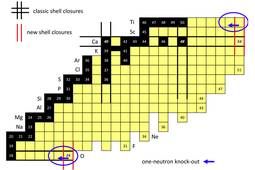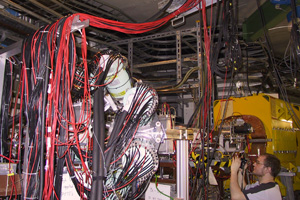22.04.2009
Evidence for new Magic Numbers in Atomic Nuclei
In two recent experiments at the accelerator facility of the Helmholtzzentrum für Schwerionenforschung, Darmstadt (GSI) scientists from groups led by Cluster member Reiner Krücken, professor at TUM, and Rituparna Kanungo, Professor at St. Mary’s University in Halifax, Canada, in collaboration with international teams, were able to provide clear evidence for new Magic Numbers in atomic nuclei. This discovery could help to gain better understanding of neutron-rich environments such as neutron stars and supernovae and therefore promote research at the Excellence Cluster Universe.
Apparently, there is a new magic shell closure at the limit of nuclear existence in the neutron-rich isotope oxygen-24 with 8 protons (a classic magic number) and 16 neutrons (a new magic number). Furthermore, the scientists came to the conclusion that shell model calculations predicting a new shell closure in calcium-54 with 20 protons and 34 neutrons correctly describe the single particle structure in the neighboring nucleus titanium-55.
The experiments studied the dynamics of reactions knocking out individual neutrons from oxygen-24 [R. Kanungo et al., Physical Review Letters 102 (2009) 152501] and titanium-56, with 22 protons and 34 neutrons, [P. Maierbeck et al., Physics Letters B 675 (2009) 22] which provided crucial information on the energies and occupation of the neutron single-particle orbitals in the respective nuclei. These experiments were highly challenging since oxygen-24 and titanium-56 are unstable radioactive beams and could be produced only with a yield of few particles per second. This has to be compared to the intensity of 10 billion ions per second typically used in experiments with stable nuclei.The shell structure of atomic nuclei with its magic numbers (2,8,20,28,50,82,126) for protons and neutrons corresponding to an enhanced binding is a cornerstone for the understanding the structure and dynamics of nuclei.
The explanation of the magic numbers in 1949 as a result of the strong spin-orbit interaction was awarded with the Nobel Prize in 1963. Until recently these magic numbers were assumed to remain universal across the whole nuclear chart. Today there is mounting experimental evidence as well as theoretical predictions indicating the shell gaps associated with the magic numbers are not universal but can change locally. This is due to variations of the effective interaction of the nucleons in the nucleus. Such changes of the shell structure not only revolutionize our understanding of the atomic nucleus but also can have dramatic effects on the production of the elements in stellar explosions events. The exact pathway of the rapid neutron-capture (r-)process through very neutron-rich nuclei beyond iron, which is believed to occur in core-collapse supernova explosions of massive stars, depends critically on the shell closure in this region of the nuclear chart. The r-process is responsible for the production of about half of the heavy elements but its exact astrophysical site as well as the exact nuclei involved remain unclear.
|
|---|
While the region of heavy neutron-rich nuclei cannot be accessed experimentally yet, modifications of shell closures can be investigated in lighter neutron-rich nuclei in order to understand the mechanisms driving such shell modifications. Here modern theoretical models predict new local magic numbers at neutron number N=16 for the oxygen isotope oxygen-24 and N=34 for the calcium isotope calcium-54 as a result of the residual interaction of the last bound nucleons. The same residual interaction may be responsible for changes of the magic numbers along the r-process path.
The experiments at GSI demonstrated the high precision momentum measurement capability at the fragment separator, FRS, for such extremely rare isotopes that will be further advanced in the near future in the FAIR facility. These results that provide the spectroscopic information proving the existence of new doubly magic nuclei will form pivotal pillars in the building of new nuclear models for understanding nuclear properties in extreme neutron-rich objects.







